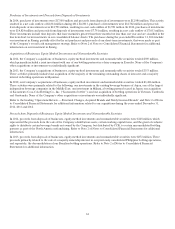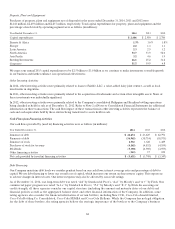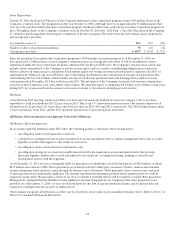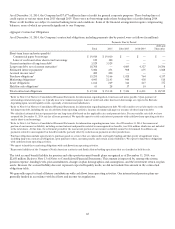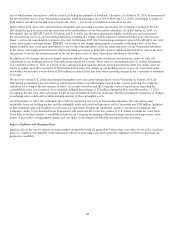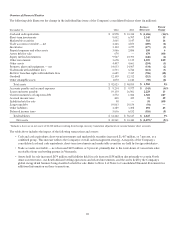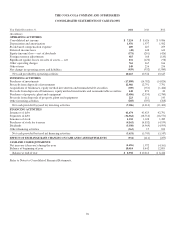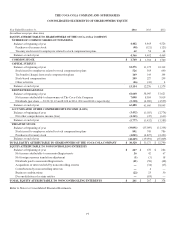Coca Cola 2014 Annual Report Download - page 69
Download and view the complete annual report
Please find page 69 of the 2014 Coca Cola annual report below. You can navigate through the pages in the report by either clicking on the pages listed below, or by using the keyword search tool below to find specific information within the annual report.
67
Foreign Exchange
Our international operations are subject to certain opportunities and risks, including currency fluctuations and governmental actions.
We closely monitor our operations in each country and seek to adopt appropriate strategies that are responsive to changing economic
and political environments, and to fluctuations in foreign currencies.
In 2014, we used 71 functional currencies. Due to our global operations, weakness in some of these currencies might be offset
by strength in others. In 2014, 2013 and 2012, the weighted-average exchange rates for foreign currencies in which the Company
conducted operations (all operating currencies), and for certain individual currencies, strengthened (weakened) against the U.S. dollar
as follows:
Year Ended December 31, 2014 2013 2012
All operating currencies
(5)% (5)% (6)%
Brazilian real
(10)% (9)% (14)%
Mexican peso
(4) 4 (7)
Australian dollar
(7) (6) —
South African rand
(12) (13) (12)
British pound
6(2) (1)
Euro 13 (9)
Japanese yen
(8) (18) 2
These percentages do not include the effects of our hedging activities and, therefore, do not reflect the actual impact of fluctuations
in foreign currency exchange rates on our operating results. Our foreign currency management program is designed to mitigate, over
time, a portion of the impact of exchange rate changes on our net income and earnings per share.
The total currency impact on net operating revenues, including the effect of our hedging activities, was a decrease of 2 percent in
both 2014 and 2013. The total currency impacts on income before income taxes, including the effect of our hedging activities, were
decreases of 9 percent in 2014 and 5 percent in 2013. Based on current spot rates and our existing hedge positions, we estimate that
currency will have an unfavorable impact of 5 percent on net operating revenues and an unfavorable impact of 7 to 8 percent on
income before income taxes for the full year of 2015. For the first quarter of 2015, we estimate that currency will have an unfavorable
impact of 6 percent on net operating revenues and an unfavorable impact of 8 percent on income before income taxes.
Foreign currency exchange gains and losses are primarily the result of the remeasurement of monetary assets and liabilities from
certain currencies into functional currencies. The effects of the remeasurement of these assets and liabilities are partially offset by
the impact of our economic hedging program for certain exposures on our consolidated balance sheets. Refer to Note 5 of Notes to
Consolidated Financial Statements. Foreign currency exchange gains and losses are included as a component of other income (loss) —
net in our consolidated financial statements. Refer to the heading “Operations Review — Other Income (Loss) — Net” above. The
Company recorded foreign currency exchange losses of $569 million, $162 million and $2 million in 2014, 2013 and 2012, respectively.
Hyperinflationary Economies
A hyperinflationary economy is one that has cumulative inflation of 100 percent or more over a three-year period. In accordance with
accounting principles generally accepted in the United States, local subsidiaries in hyperinflationary economies are required to use
the U.S. dollar as their functional currency and remeasure the monetary assets and liabilities not denominated in U.S. dollars using
the rate applicable to conversion of a currency for purposes of dividend remittances. All exchange gains and losses resulting from
remeasurement are recognized currently in income.
Venezuela has been designated as a hyperinflationary economy. In February 2013, the Venezuelan government devalued its currency
to an official rate of exchange (“official rate”) of 6.3 bolivars per U.S. dollar. At that time, the Company remeasured the net monetary
assets of our Venezuelan subsidiary at the official rate. As a result of the devaluation, we recognized a loss of $140 million from
remeasurement in the line item other income (loss) — net in our consolidated statement of income.
Beginning in the first quarter of 2014, the Venezuelan government recognized three legal exchange rates to convert bolivars
to the U.S. dollar: (1) the official rate of 6.3 bolivars per U.S. dollar; (2) SICAD 1, which is available to foreign investments
and designated industry sectors to exchange a limited volume of bolivars for U.S. dollars using a bid rate established at weekly
auctions; and (3) SICAD 2, which applies to transactions that do not qualify for either the official rate or SICAD 1. As of
March 28, 2014, the three legal exchange rates were 6.3 (official rate), 10.8 (SICAD 1) and 50.9 (SICAD 2). We determined that
the SICAD 1 rate was the most appropriate rate to use for remeasurement given our circumstances and estimates of the applicable






